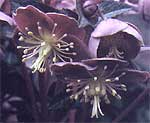
 |
|
Helleborus lividus Aiton
Some gardeners regret that Helleborus lividus is not hardier - and it is true that in the majority of British gardens an average winter is too much for it. But this is one of only two species that could genuinely be described as tender so complaining about its delicacy seems an unnecessarily bitter condemnation. There are forms of H. x sternii which fill the role of a hardy lividus in the open garden, so why not view the suitability of this species for cultivation in a cold greenhouse, where it will flower in mid winter, as a characteristic to be admired rather than deprecated? And such a distinctive plant should surely be appreciated as a welcome companion to alpine house plants, bringing a habit and style missing from most other alpines, rather than condemned for its lack of toughness.
This is, after all, a beautiful plant with a unique combination of foliage and flower admired by everyone who sees it. It is not difficult to grow given the right conditions and it deserves to be grown more widely. The only problem is that true plants and seed are scarce, for this species crosses easily with H. argutifolius if it is within bee-flight.
Description
Unlike most hellebores H. lividus produces all its leaves and flowers on short stems. When the plant is not in flower the foliage may make a low mound no more than 6-9in (15-23cm) high but at flowering time its height can stretch to 15in (38cm) or even more. The stems are green with a varying degree of pink flushing. The leaves are generally deep green in colour, usually with a greyish sheen, and with the leaf veins picked out clearly in silver or cream. This colour is especially noticeable in young seedlings. The backs of the leaves are a slightly misty pink, the colour may vary from pale to quite deep.
Each leaf is divided into three leaflets; the central one is more or less elliptical in shape, but the outer two are skewed in the same way as those of H. argutifolius, owing to their outside edge being noticeably longer than the inside edge. The margins of the leaves may be entirely smooth, they may have just a few small, widely spaced teeth or the teeth may be spaced rather more tightly; closely spaced teeth are usually only a feature of young seedlings.
Flowering usually starts in December and continues through March. The cup-shaped flowers are carried in heads of up to eight or ten on more luxuriant specimens, but generally fewer, and open out almost flat as the flower ages. Each flower is 1-11/2in (2.5-4cm) across, apple green inside and out with a strong pink or purple tint to the backs of the petals, especially along the veins, and tinted in a similar way inside the flower but to a lesser degree.
The most distinctive feature of this plant is its general pink tint which is especially noticeable on the undersides of the foliage, on the stems, the leaf petioles and the flowers. The silvery veining on the upper surface of the leaves is also very striking. It can be confused with some dark tinted, dwarf forms of H. x sternii but here the foliage usually gives it away. In H. lividus the leaf edge may have a few small, widely spaced teeth but more often it is completely smooth. In H. x sternii the leaf edge inherits something of the more frequent,spinier look of its other parent, H. argutifolius.
Natural distribution and habitat
Helleborus lividus has the most limited natural distribution of all hellebores and even in its area of distribution it is very scarce. The island of Majorca is its main home, and although it was once found on the nearby island of Cabrera, its status there is now in doubt. It is now a very rare plant. Will Mclewin spent a week on the island in 1991 with the specific aim of finding it and in spite of looking in a wide range of likely sites found only three plants growing in one spot.
On Majorca H. lividus is confined to the mountains along the north east coast; it is rarely found below 100m. The one thing that the sites in which it grows seem to have in common is that they are relatively moist compared with surrounding areas. So it is found growing along the sides of river beds, above the water line but within reach of spray, and also in the shingle in seasonal streams which dry out in summer, known as torrent beds. It is also found in the shingle at the base of rocks and boulders where its roots can penetrate into the cooler, less dry conditions underneath and also on damp cliff faces. It has also been found amongst rose scrub at the base of limestone cliffs.
The highest parts of these mountains are very difficult to reach, many miles walk from the nearest road, and the country is rugged so it is quite possible that significant populations are still to be discovered.
We have used the word 'is' in this account but it is clear from people who have botanised on the island in recent years that H. lividus has become increasingly rare. Whilst it could once be seen within walking distance of hotels, development has swallowed up these sites in spite of the fact that the mountains where it grows are less popular with tourists than the sandy coasts on the opposite side of the island. Extensions of cultivated areas into wilder country have also reduced its habitat although the plants seem to suffer less from goats than do some other plants in the area.
In the stony debris in the torrent beds it grows with that other Majorcan endemic Paeonia cambessedesii and also Digitalis dubia and Helleborus foetidus. On the occsasions when H. lividus is found on more open hillsides it grows with Hypericum balearicum and Teucrium spinosum.
Cultivation
As this species is not reliably hardy, and with plants and seed so hard to come by, risking it outside would be foolhardy until you have built up a good stock of plants; it is best grown in a bed in a cold greenhouse or in a large pot. When making up a mixture, for bed or pot, a good blend would be four parts of John Innes Potting Compost Number 2 plus one part leaf mould or fine bark plus one part grit. If you prefer to mix your own from scratch a suitable mixture would be two parts fine bark, one part sterilised loam, one part grit, plus 3/4oz chalk per bushel (8 gallons) and four flat desertspoonfuls of Osmocote per bushel.
The plants can be potted into crocked pots with 1in (2.5cm) of grit in the bottom then top dressed with grit. Clay pots look better than plastic and they should be steadily potted on as they grow until they are in no larger than 15in (38cm) pots. Try and move them on in small stages for if they are moved into large pots too soon the compost will hold too much water and the roots may rot.
As your plant grows larger, it pays to select and grow on a good seedling as a replacement. Plants should be at their best for five or six years in pots but will eventually decline so it is useful to have a replacement coming on.
Pots should be placed outside from after the last frost until the end of September, in plenty of light but shaded from midday sun, and kept moist. In winter they should be moved into a well ventilated cold greenhouse and watered carefully. They appreciate as much air as possible except when frost threatens when the vents should be closed. When an especially penetrating frost is likely the plants should be covered with one or two sheets of newspaper as an added protection.
Aphids can build up unnoticed in winter so check regularly and spray with an insecticide containing pyrimor if necessary. Watch too for black spot, which can attack the foliage in muggy winters and may also attack the base of the old flowering stems as seed is developing. At times it can be a race between the black spot killing the stem and the seed ripening so regular spraying is essential. Cut out the stems after seed has been collected to allow the new foliage to develop unhindered.
A feed of liquid fertiliser three or four times between moving the plant outside in early June and the end of August will help fortify the plant for flowering during the winter.
Propagation is by seed. This will ripen in about May and is best sown within the next couple of months. It has been suggested that the seed be stored dry until October but there seems little point in this and the simplest approach is to sow it with your other hellebores in the summer. Seed of H. lividus is always the first to germinate, usually in October and invariably before Christmas. The seedlings are delightfully veined and a potfull is itself very pretty, reminiscent of Cyclamen graecum.
If you have H. argutifolius in the garden you will need to take precautions to prevent bees bringing pollen into the greenhouse and giving you H. x sternii offspring instead of H. lividus. All the vents can be netted and the greenhouse door kept closed but then, of course, you will need to hand pollinate as there will be no bees to do it for you. Having excluded the possibility of contamination from foreign pollen there is no need to open the buds early to pollinate, you can simply rub the open flowers gently on to one another to transfer pollen. If you prefer not to net (and keeping the door closed on sunny days can help increase the temperature in the greenhouse alarmingly) you must hand pollinate by opening the buds as for other hellebores.
Finally a word of warning. Because these precautions are rarely adhered to as carefully as they might be, seed offered in seed lists and elsewhere often turns out to be, at least in part, H. x sternii. So try to ensure that your original stock really is true H. lividus and then help other gardeners enjoy this lovely plant by hand pollinating the flowers and passing round seed or seedlings of the true plant.
In gardens
Flowering as it does in the depths of winter, and requiring protection from the worst of winter cold but little more, this is a fine alpine house plant for the back of the bench where its height will complement the dwarf bulbs and cushion plants which are such a feature of the early months in the alpine house. Its delightful foliage and flowers will add their own very special elegance. It can also be grown in a Mediterranean bed in the greenhouse and in a few favoured gardens it can even be grown outside.
 |
|
|
|
|